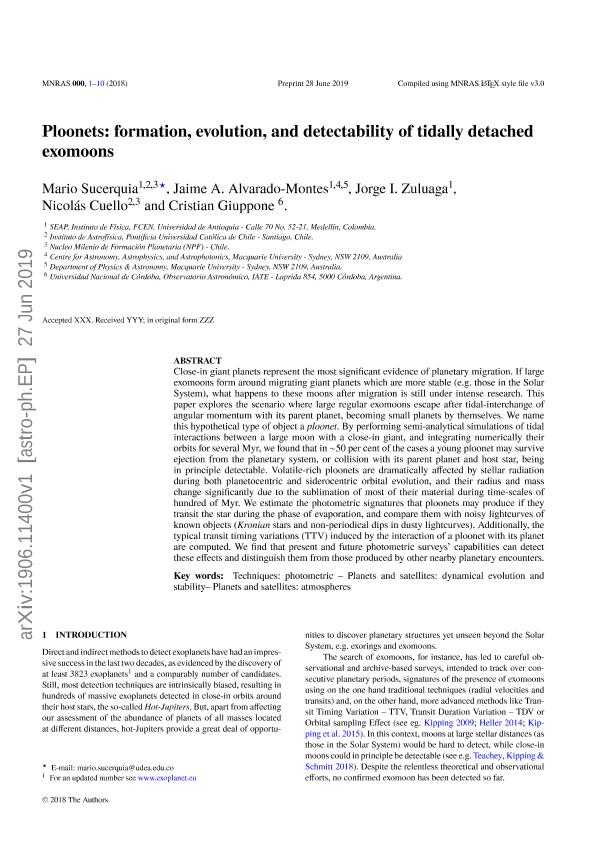Artículo
Ploonets: Formation, evolution, and detectability of tidally detached exomoons
Sucerquia, Mario; Alvarado-Montes, Jaime A.; Zuluaga, Jorge I.; Cuello, Nicolas; Giuppone, Cristian Andrés

Fecha de publicación:
07/2019
Editorial:
Wiley Blackwell Publishing, Inc
Revista:
Monthly Notices of the Royal Astronomical Society
ISSN:
0035-8711
e-ISSN:
1365-2966
Idioma:
Inglés
Tipo de recurso:
Artículo publicado
Clasificación temática:
Resumen
Close-in giant planets represent the most significant evidence of planetary migration. If large exomoons form around migrating giant planets which are more stable (e.g. those in the Solar system), what happens to these moons after migration is still under intense research. This paper explores the scenario where large regular exomoons escape after tidal interchange of angular momentum with its parent planet, becoming small planets by themselves. We name this hypothetical type of object a ploonet. By performing semi-analytical simulations of tidal interactions between a large moon with a close-in giant, and integrating numerically their orbits for several Myr, we found that in ∼50 per cent of the cases a young ploonet may survive ejection from the planetary system, or collision with its parent planet and host star, being in principle detectable. Volatile-rich ploonets are dramatically affected by stellar radiation during both planetocentric and siderocentric orbital evolution, and their radius and mass change significantly due to the sublimation of most of their material during time-scales of hundreds of Myr. We estimate the photometric signatures that ploonets may produce if they transit the star during the phase of evaporation, and compare them with noisy light curves of known objects (Kronian stars and non-periodical dips in dusty light curves). Additionally, the typical transit timing variations (TTV) induced by the interaction of a ploonet with its planet are computed. We find that present and future photometric surveys' capabilities can detect these effects and distinguish them from those produced by other nearby planetary encounters.
Archivos asociados
Licencia
Identificadores
Colecciones
Articulos(IATE)
Articulos de INST.DE ASTRONOMIA TEORICA Y EXPERIMENTAL
Articulos de INST.DE ASTRONOMIA TEORICA Y EXPERIMENTAL
Citación
Sucerquia, Mario; Alvarado-Montes, Jaime A.; Zuluaga, Jorge I.; Cuello, Nicolas; Giuppone, Cristian Andrés; Ploonets: Formation, evolution, and detectability of tidally detached exomoons; Wiley Blackwell Publishing, Inc; Monthly Notices of the Royal Astronomical Society; 489; 2; 7-2019; 2313-2322
Compartir
Altmétricas



